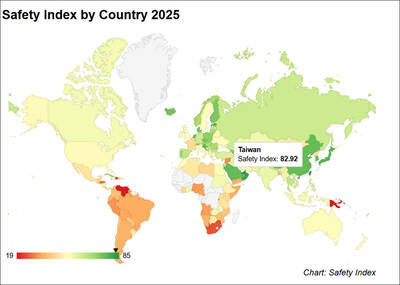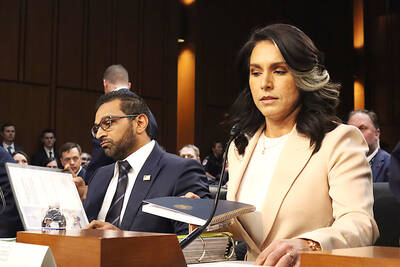Beijing is willing to use force to achieve its political goals, and although China's military does not yet have the ability to conquer Taiwan, especially if other countries intervene in a cross-strait conflict, the military gap between the two nations is widening, the Pentagon said in a report released yesterday.
In addition to Chinese efforts to create a modern military, the report cited Taiwan's lack of progress in military procurement as a major problem.
The report also warned of the possibility that the Chinese Communist Party could, nevertheless, lead China into a war through overconfidence or desperation caused by internal upheavals.
The US Department of Defense's annual report to Congress on "The Military Power of the People's Republic of China" was released yesterday after weeks of internal government wrangling over various details included in the document.
The report highlights the growing concern among US officials over China's rapid modernization of its military forces and pugnacity regarding Taiwan, as well as frustration over the special arms budget bill that has been blocked by the pan-blues in the legislature.
"Taiwan's defense spending has steadily declined in real terms over the past decade, even as Chinese air, naval, and missile force modernization has increased the need for countermeasures that would enable Taiwan to avoid being quickly overwhelmed," the report said.
The report also, on two separate occasions, points out that the NT$410.8 billion (US$15 billion) special arms budget -- which would allow Taiwan to purchase eight diesel-electric submarines, 12 P-3C Orion maritime patrol aircraft and three PAC-3 Patriot anti-missile batteries from the US -- is awaiting approval by the Legislative Yuan.
Meanwhile, China was becoming ever stronger, the report said.
"The cross-strait military balance appears to be shifting toward Beijing as a result of China's sustained economic growth, growing diplomatic leverage, and improvements in the PLA's [People's Liberation Army] military capabilities, including those that provide Beijing options short of full-scale invasion," the Pentagon said in the report.
"Beijing continues to see the threat and possible use of force as integral to its policy of dissuading Taiwan from pursuing independence and moving Taiwan ultimately to unite with the mainland," the report said.
However, it also said that a military strike against Taiwan would most likely not accomplish Beijing's stated goal of unification.
"China does not yet possess the military capability to accomplish with confidence its political objectives on the island, particularly when confronted with outside intervention," the report said.
"Outside intervention" would almost certainly be in the form of US and Japanese military action, according to the report.
"Beijing sees Washington and, increasingly, Tokyo as the principal hurdles to any attempt to use military force to coerce or capture Taiwan," the report said. Therefore, "Beijing will pursue diplomatic efforts to keep the United States and Japan from taking action to support Taiwan."
Although China has made significant advances in its military capabilities over the past decade, there were still serious deficiencies in its capabilities and overall structure, the report said.
But that would change with time, it said.
"The US intelligence community estimates that China will require until the end of this decade or later for its military modernization program to produce a modern force, capable of defeating a moderate-size adversary," the report said.
China is estimated to spend between US$50 billion and US$70 billion a year on its military budget, making it the third largest defense spender in the world. The US, which spends more money on defense than any other nation, has a military budget of approximately US$400 billion.
One of the key goals to China's military transformation is to thwart intervention by the US or other countries in the Taiwan Strait, the Pentagon said.
"Preventing foreign military intervention, particularly along China's coast, has been a goal for Beijing throughout history, reinforcing the geostrategic value of Taiwan for China's security planners," the report said.
Currently, Beijing does not appear to be contemplating military action against Taiwan, primarily because of two factors: Lack of military capabilities and "potential repercussions of any use of force against Taiwan."
One of those repercussions would be severe, long-term damage to China's economy, in part because Taiwan is the authoritarian giant's largest source of foreign direct investment.
Still, the report said, there was plenty of room for the Chinese Communist Party to miscalculate its military capabilities and the international situation, thus leading to a cross-strait conflict involving the US and Japan.
"China's leaders may overestimate the proficiency of their forces," the report said.
"Beijing could use limited strikes, employing information operations, special operations forces on Taiwan, and SRBM [Short-range Ballistic Missiles] or air strikes at key military or political sites, to try to break the will of Taiwan's leadership and population," the Pentagon wrote.
"Although Beijing might view these as a complement to non-military coercion and as less than a full use of force, others may view such actions differently," it said.
"Such a Chinese miscalculation could lead to a full-fledged conflict."

AIR SUPPORT: The Ministry of National Defense thanked the US for the delivery, adding that it was an indicator of the White House’s commitment to the Taiwan Relations Act Deputy Minister of National Defense Po Horng-huei (柏鴻輝) and Representative to the US Alexander Yui on Friday attended a delivery ceremony for the first of Taiwan’s long-awaited 66 F-16C/D Block 70 jets at a Lockheed Martin Corp factory in Greenville, South Carolina. “We are so proud to be the global home of the F-16 and to support Taiwan’s air defense capabilities,” US Representative William Timmons wrote on X, alongside a photograph of Taiwanese and US officials at the event. The F-16C/D Block 70 jets Taiwan ordered have the same capabilities as aircraft that had been upgraded to F-16Vs. The batch of Lockheed Martin

GRIDLOCK: The National Fire Agency’s Special Search and Rescue team is on standby to travel to the countries to help out with the rescue effort A powerful earthquake rocked Myanmar and neighboring Thailand yesterday, killing at least three people in Bangkok and burying dozens when a high-rise building under construction collapsed. Footage shared on social media from Myanmar’s second-largest city showed widespread destruction, raising fears that many were trapped under the rubble or killed. The magnitude 7.7 earthquake, with an epicenter near Mandalay in Myanmar, struck at midday and was followed by a strong magnitude 6.4 aftershock. The extent of death, injury and destruction — especially in Myanmar, which is embroiled in a civil war and where information is tightly controlled at the best of times —

Taiwan was ranked the fourth-safest country in the world with a score of 82.9, trailing only Andorra, the United Arab Emirates and Qatar in Numbeo’s Safety Index by Country report. Taiwan’s score improved by 0.1 points compared with last year’s mid-year report, which had Taiwan fourth with a score of 82.8. However, both scores were lower than in last year’s first review, when Taiwan scored 83.3, and are a long way from when Taiwan was named the second-safest country in the world in 2021, scoring 84.8. Taiwan ranked higher than Singapore in ninth with a score of 77.4 and Japan in 10th with

SECURITY RISK: If there is a conflict between China and Taiwan, ‘there would likely be significant consequences to global economic and security interests,’ it said China remains the top military and cyber threat to the US and continues to make progress on capabilities to seize Taiwan, a report by US intelligence agencies said on Tuesday. The report provides an overview of the “collective insights” of top US intelligence agencies about the security threats to the US posed by foreign nations and criminal organizations. In its Annual Threat Assessment, the agencies divided threats facing the US into two broad categories, “nonstate transnational criminals and terrorists” and “major state actors,” with China, Russia, Iran and North Korea named. Of those countries, “China presents the most comprehensive and robust military threat